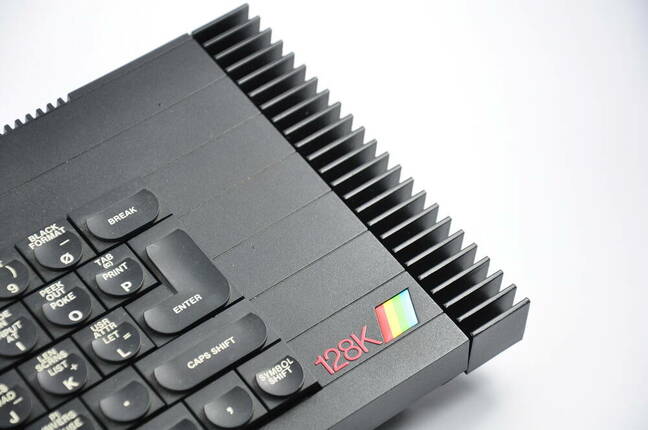

The New ROM Antics – building the ZX Spectrum 128
source link: https://www.theregister.com/2024/01/15/opinion_column_zxspectrum_128/
Go to the source link to view the article. You can view the picture content, updated content and better typesetting reading experience. If the link is broken, please click the button below to view the snapshot at that time.

The New ROM Antics – building the ZX Spectrum 128
If you think Sinclair’s hardware was odd, you haven’t met the people
Opinion Following an unlikely series of events involving British Telecom, Prince Philip and a VTX-5000 modem, your teenage protagonist found himself at a drunken dinner party in 1984's West London. Across the table, excitingly, sat my boyhood hero Sir Clive Sinclair, and he seemed genuinely interested in what I had to say about the Sinclair QL, which was not thriving.
It turned out he was mostly trying to work out where he’d heard my voice recently. "I’ve got it!" he said. "You were the hacker on the news!" I had indeed been interviewed in silhouette on the news the week before regarding the unlikely events, and I admitted as much.
The week after, his secretary phoned me to see if I wanted a job at Sinclair Research Limited (SRL)’s London office. Clive never said so outright, but the understanding was that I’d hack Acorn to find out what it was up to, and so I was installed with an ICL OPD, a mutant QL/modem machine, and left alone. The idea was ludicrous, but just before it became too ludicrous to ignore the urgent call came from SRL in Cambridge for a Z80 assembler programmer for an urgent project. I’d already said at the dinner party that I’d taught myself Z80 on first a ZX81, then a Spectrum. I was already on the books, so up I went, trailing my OPD behind me.
The rush job was the UK launch of the ZX Spectrum 128, now known as the Toast Rack because of the lake heatsink bolted on the side. The first had already been launched in Spain. It had the extra RAM and the sound chip, but only the original Spectrum firmware. Good enough if you think of the Speccy as a mere games machine, and thus deemed probably good enough for the Spanish market, but SRL knew that it was a serious educational, even borderline business, computer. Reality was always optional.
An extended BASIC with a full-screen text editor for programming and full support for the new hardware was the least the UK market deserved. Which meant modifying the original ROM. Which first meant being able to rebuild that ROM from the source code. Which was a huge heap of mostly uncommented Z80 mnemonics living, somewhat bizarrely, on a VAX 11/750. I was given a seat, a VT-220 terminal, manuals for VMS and CP/M, and left to get on with it.
If you were there at the time, you will remember that Sinclair was famous for delivering stuff late. There were many reasons for that, but running projects by throwing untested naive enthusiasts into a production environment without any sort of qualifying test exemplified the organization's management style. If SEL could be called organized or managed. Many very bright people fought nobly and well to establish corners of stability; many more very bright people were guided by their substantial skills filtered by their substantial egos.
I loved it all. I worked out how to make the VAX run CP/M, how to make the original source code work with the M80 CP/M assembler, and rebuilt the ROM as a saner set of modules with proper comments. I stole copiously from The Complete Spectrum ROM DIsassembly by Ian Logan and Frank O’Hara, a book from which I'd learned my Spectrum licks in the first place and without which the 128 would have arrived much much later.
Then it was on to writing the new code for the new ROM. I did a bunch of cosmetic and peripheral stuff – the most obvious of which was the menu system that comes up on power on. Almost vestigially useless, this was the subject of endless meetings as to what should go where and why. These exemplified SRL’s tribal structure, where the Hardies, the Softies (my tribe) and the Marketers battled for turf, inch by inch. You’ll notice two tribes missing: production, who had to make it all work, and the users, who decided whether to buy the stuff. Yeah, about that.
My one small spot of inconsequential pride was pointing out at one of the menu meetings that we could add the Spectrum rainbow flash to the menu title bar, if we were careful about attributes. The Hardies couldn’t find anything to complain about and the Marketers were actually enthusiastic. In it went. Every time you see that tiny splash of color, think of that rare moment where peace broke out. Every quirk in every retro box that you find lovely or mystifying is there because some long-forgotten member of an ancient team nipped a tiny twist of creativity out of an embattled process. Think of them from time to time.
There are many stories from behind those particular 8-bit battle lines. The technicalities of testing dodgy software on dodgy hardware. Compatibility testing hundreds of 48k games on 128 prototypes. Eric the Wireman’s betting habits. Moving out of the Cambridge HQ to the out-of-town top secret Metalab as the money ran out. The dying days of the QL. Building the Pandora portable Spectrum prototype out of a Timex-Sinclair TS-2068 and modded Blade Runner tech. Yes, really.
Yet if I learned anything at Sinclair*, it’s to promise everything except a delivery date. Old habits die hard – but a recapped Spectrum goes on forever. ®
* I also learned that writing system software for a paged memory map and no MMU is as much fun as root canal work via nostril. Don’t ask.
Recommend
About Joyk
Aggregate valuable and interesting links.
Joyk means Joy of geeK

